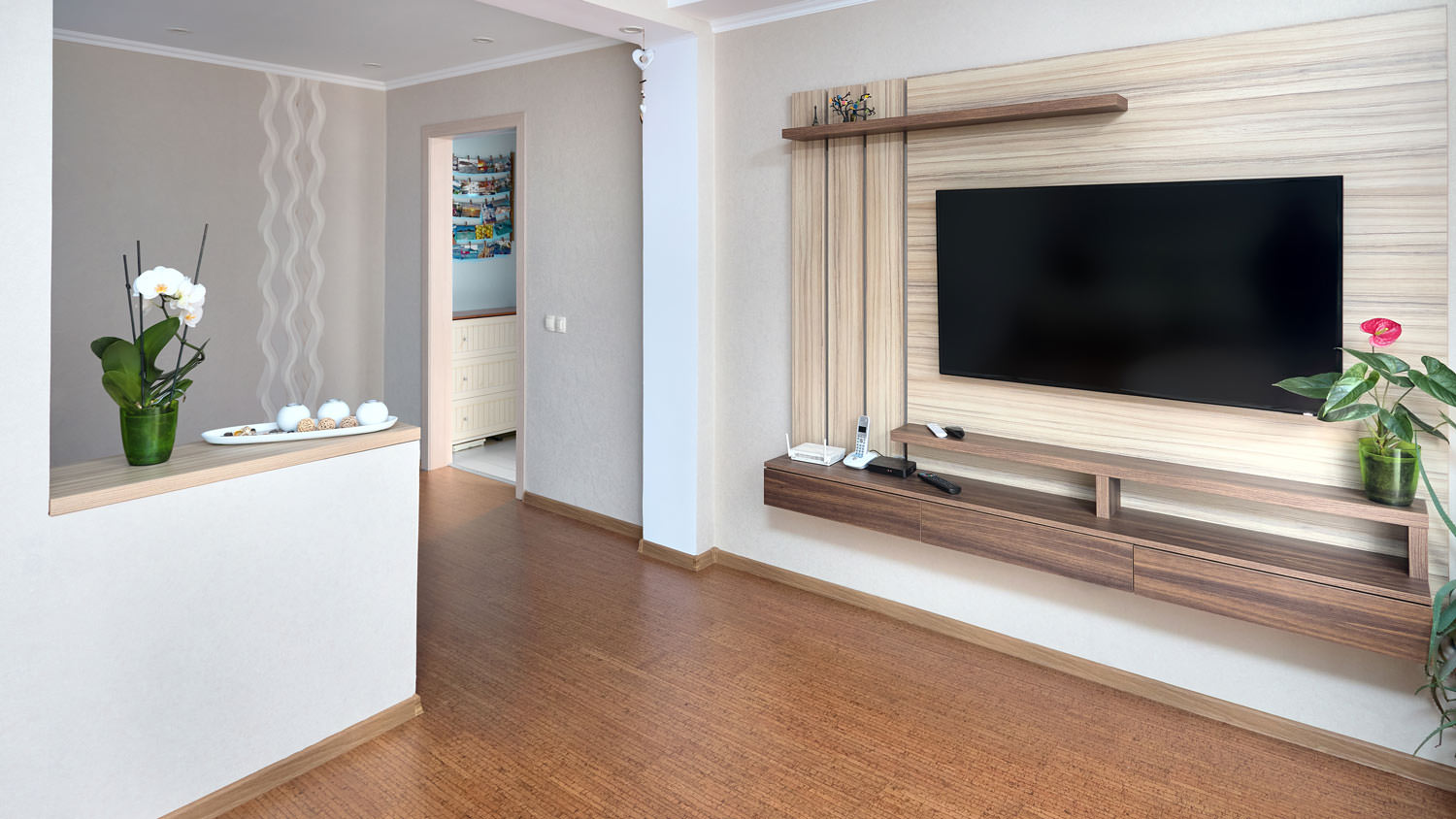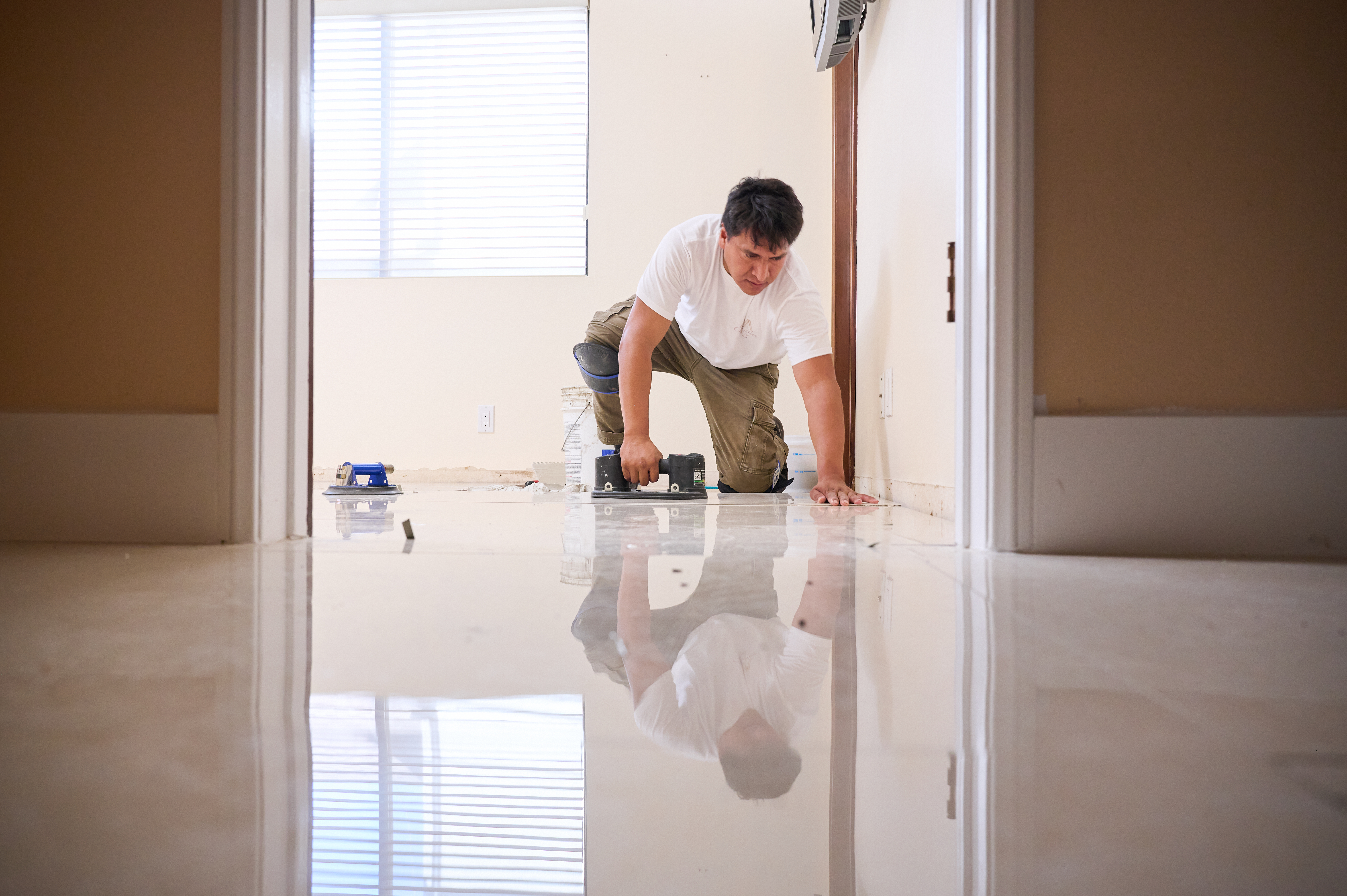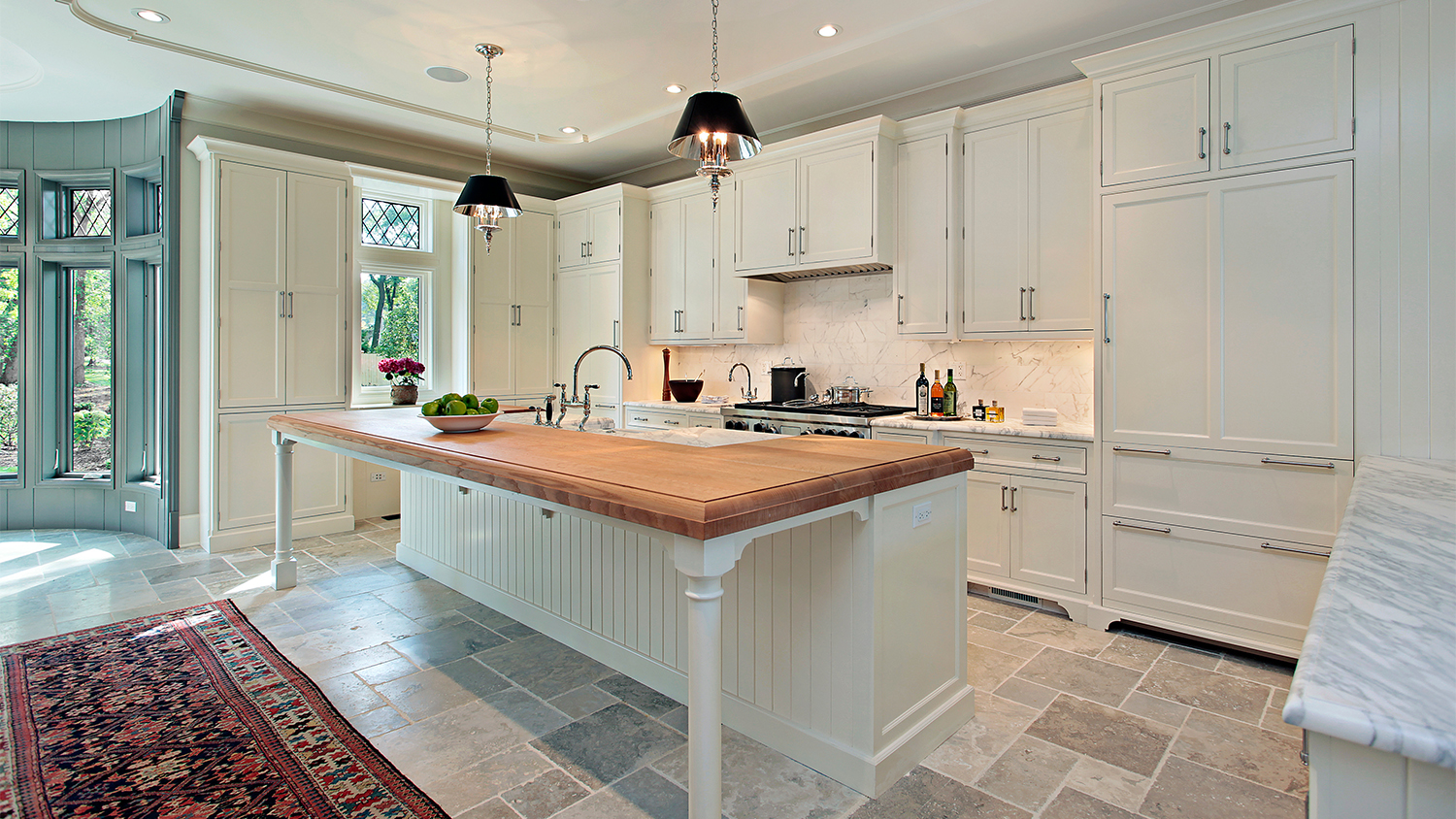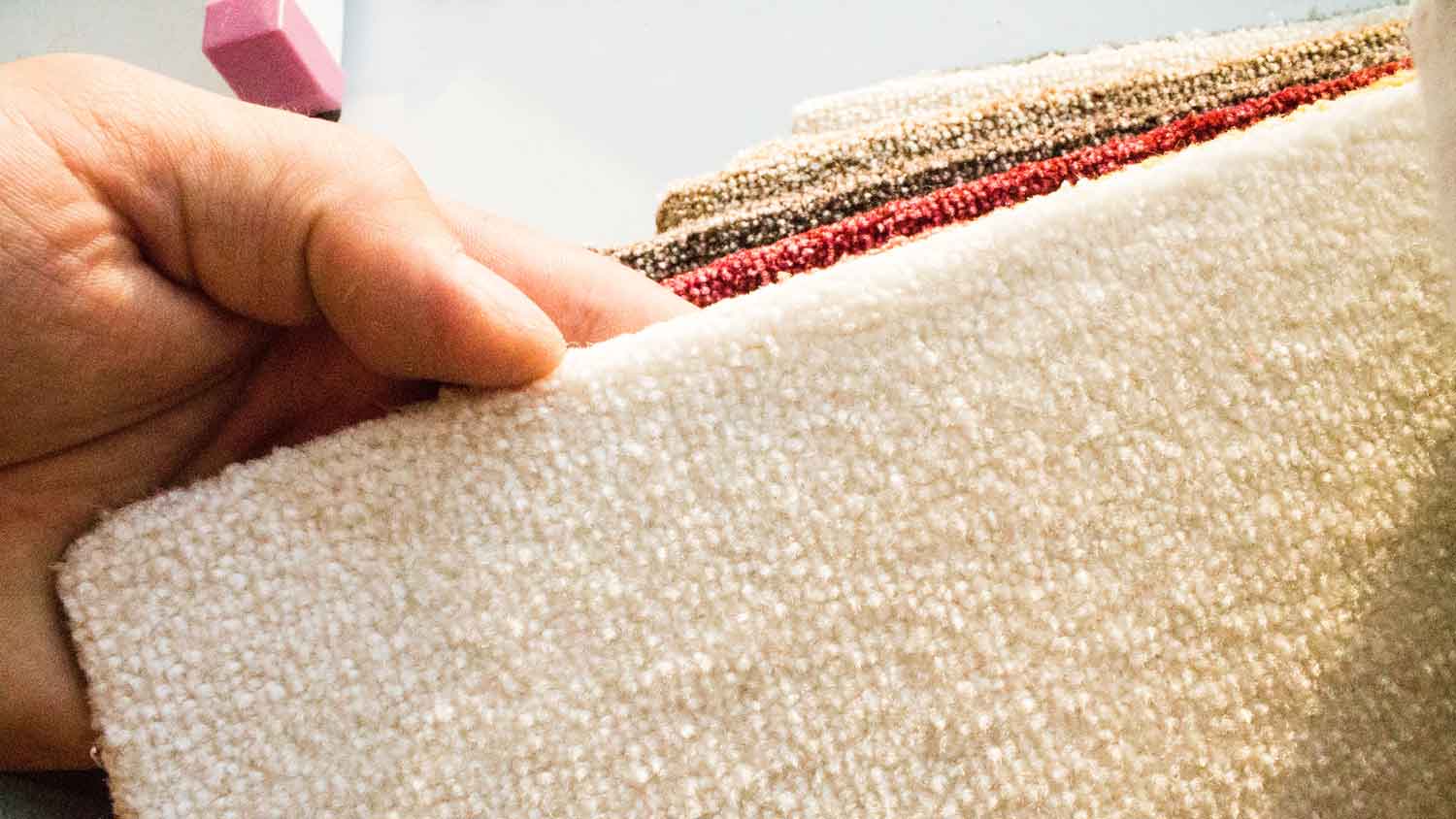
Staining concrete floors can add a little something to a drab slab. Learn more about how much stained concrete floors cost and what factors impact it.
Give your laminate flooring a little TLC


DIY laminate repair methods include using filler, putty, and wax pencils, but a laminate floor pro will use more sophisticated techniques for a seamless finish.
DIY mistakes can cause further damage, such as cracking, chipping, and uneven floors.
Buckled or water damaged planks usually can’t be repaired and must be replaced instead.
A pro can spot any underlying issues that may cause further damage to the floor.
Laminate flooring is a great option for many homeowners, thanks to its budget-friendly price tag and ability to mimic many popular floor choices like hardwood or stone. It is a hearty material that requires little maintenance.
Accidents do happen, however, and laminate flooring is susceptible to cracks, buckling, moisture damage, and more. Before contacting a local floor repair specialist, learn how to repair laminate flooring and possibly do the repair yourself.

So, you have noticed damage and now you are wondering how to fix laminate flooring. Read on to find out common repair types and how to get them done.
Scratches are extremely common, so learning how to fix them on laminate flooring is a useful skill to have. There are plenty of tools for simple DIY repairs, including wax pencils, repair putty, or a laminate repair kit.
Wax pencils are a great tool for repairing minor scratches to laminate flooring.
Find a wax pencil that matches your floor’s color. You can find these wax pencils at hardware stores, stationery stores, or online.
Use the wax pencil to rub the scratch with short strokes, moving slowly back and forth. Try rubbing at a right angle for the best results.
Then rub the scratch dry with a clean cloth to perform some simple buffing.
If the scratch remains, repeat the process or move on to another method.
For deeper and hollowed scratches, turn to repair putty.This type of putty is available at hardware stores, online, or through the original laminate flooring manufacturer.
Rub the repair putty on the scratched area using the putty knife.
Scrape off any excess putty to flatten and level the area.
Let the putty dry for 24 hours, but no longer as soft putty is easier to remove than hardened putty.
Remove the putty with the knife and marvel at your scratch-free flooring.

If the wax pencils and repair putty did not help, you will have to try the most comprehensive option to fix laminate floor scratches, which is a laminate flooring repair kit. These kits are available at local hardware stores. To find an exact color match, bring a small sample of your flooring to the store and ask for the appropriate repair kit.
Start by using the applicator to remove any noticeable splinters near or on the scratches.
Next, find the burn-in sticks to fill the scratch. Mix different shades of burn-in sticks to match your floor color.
If necessary, use fine-grit sandpaper to level the area to the rest of the floor.
Wipe the area clean with a damp cloth to remove dust, dirt, and debris.
Apply acetone or varnish according to the kit’s instruction manual.
Let the area dry for 24 hours.
On occasion, minor accidents cause laminate flooring to peel or chip. There are a couple of methods for fixing this problem and getting your floor back in tip-top shape.
Both wood- and acrylic-based filler are great options for repairing chips and peels with laminate flooring. Either works well, so pick the product that best matches the color of your floor. Also, purchase a cleaning solvent and a putty knife as part of this process.
Remove any splinters with a putty knife or, very carefully, with a sharper blade.
Apply the cleaning solvent onto the peeled or chipped area, following the manufacturer’s instructions.
Spread the wood or acrylic filler on the putty knife.
Apply the filler slowly and carefully over the impacted area.
Before it dries fully, apply another shallow layer of filler over and press gently with the putty knife.
Clean off any excess filler and allow it to dry overnight.
In addition to fixing scratches, repair putty is a great resource for repairing small chips and peels. Follow the above repair process under scratches, with the only difference being the amount of putty used, which depends on the size of the chip or peeled area. Be sure to follow the manufacturer’s instructions for best results.
Moving furniture around or dropping a heavy object on the floor can cause denting to the laminate. Fortunately, there is an easy fix using a standard clothing iron and the magic of steam.
Pour a drop or two of water on top of the dent.
Grab a clean cloth, moisten it, and fold it four times to decrease the size to around one square inch.
Lay it on the dent and press gently, leaving it there.
Preheat your iron and place the tip on the cloth, moving it in a circular motion until you see steam rising.
Keep moving the iron, applying moderate force, for around three minutes until the steam dissipates.
Remove the iron and cloth. The ultra-hot steam likely eliminated the dent. If not, repeat the process.
If the steam causes any floor discoloration, apply an oil stain that matches your flooring color.

Soft spots in laminate flooring develop after improperly installing the underlayment or from general weather and tear. Grab a can of spray foam and an air installation needle extension to fix this issue.
Plug the extension into the spray foam can.
Apply a layer of masking tape to the laminate flooring to protect it from the foam. You should go underneath the laminate, not on top of it.
Use a power drill to drill a very small hole right in the middle of the soft spot. Be sure to use the smallest drill setting possible.
Insert the extension into the hole and inject spray foam. You will need multiple injection sites for large soft spots.
Remove any excess foam and immediately cover the hole with duct tape.
Once satisfied with the results, use a matching wood filler or repair putty to fill the hole.
Unfortunately, significant water damage to your floor and buckling do not have simple DIY fixes. The only solution is to replace the damaged laminate planks. This method requires a certain level of expertise, some specialized tools, and a few hours of your time, so it may be easier to hire a professional for this repair rather than doing it yourself.
Here is a simple rundown of the process for replacing damaged laminate flooring.
Inspect the flooring and locate damaged areas. Mark impacted planks for replacement.
Remove the damaged planks with a putty knife or pry bar.
Remove moisture from the subfloor (in the case of water damage) via vacuum or clean cloths. Allow the area to dry thoroughly before laying down new planks.
Acquire new planks through the original manufacturer or by sizing some out at a hardware store.
Before installing, let the new planks acclimate to your home for two or three days to match humidity and temperature.
Click the new planks into place by hand or by using a hammer.
If needed, install any finishing nails with a hammer.
There are several ways a laminate floor will let you know it’s time for crucial repairs. Here’s what to be on the lookout for:
Squeaking or cracking: These sounds likely mean the interlocking mechanics of the laminate panels need repair.
Foul odor: Laminate flooring can attract mold and mildew, especially after coming into contact with moisture, which leads to the smell.
Saggy or bouncy floors: Take a walk over the flooring. If you feel a bouncing or sagging sensation, it could indicate an issue with the subfloor.
Fading color: This indicates prolonged exposure to sunlight but could also indicate extreme age.
Physical imperfections: Laminate flooring is not immune to scratches and chips. If you spot a bunch of physical imperfections, it’s likely time for a repair visit.
Now that you have fixed your laminate floors, it is time to take care of them so they will last as long as possible. Here are some tips for maintaining and cleaning laminate flooring:
Clean up spills right away.
Use the right cleaning products.
Avoid abrasive cleaning tools.
Dust with vacuum or microfiber mop.
Only use damp mops.
Consider making the area shoe-less.
Protect flooring when moving furniture.
Laminate floor repair costs $150 to $5,000, depending on the problem, and installing new laminate floors costs an average of $2,985. Here are some common repair costs you can expect if you hire a pro to help:
| Type of Repair | Average Cost |
|---|---|
| Scratches and gouges | $100–$300 |
| Stains | $75–$300 |
| Replacing Planks | $3–$11 per square foot |
| Buckling or bubbles | $3–$11 per square foot |
| Soft spots | $250–$750 |
The average cost to repair laminate flooring is $825, but it can vary based on the type of repair. Most of the above repair-related issues are easily handled with simple household items and tools available at hardware stores. However, in the case of buckled or water-damaged planks, consider hiring a floor repair company near you for a fuss-free replacement process.
I found Erica on Craigslist and explained my situation. She quoted me a very fair price and on the day she came over with her crew they went to work and my place was filthy, they took about 90 minutes to clean it floor to ceiling. My apartment was cleaner than when i moved it. I am so happy...
Chris, the tech, left unfinished and he won't return my calls. the job Leaked. Needs attention. Chris won't return my calls. He won't come back to finish the job. Chris installed the upgrade to my shower including fixtures. He installed the fixtures upside down, with no hot water. The job...
I requested specific things, like bathroom faucets. They took my step in tub and ordered the wrong thing. They didn't order a single thing right. Nothing matches. The only things that came out right were things that I didn't order from Lowe's. I signed a contract with them and another...
Recently my air conditioning went out in my home. This was on a Sunday. . I started to run the gambit and make several phone calls to several companies. I had two companies that told me there is an additional charge for weekend service calls. .I'm not sure if it was the actual technician I...
The crew arrived when they said they would and quickly removed the old roof and installed the new one. They were finished in one day and did an excellent job. They cleaned up the worksite like they hadn't even been there. The company scheduled the inspector to be there and finished...
My first issue was....When they were 15 minutes last i called and no response. Another 15 minutes or so went by and I texted and eventually I called again. 3rd time I called I got an answer and the owner had the following day scheduled. He came over on the same day and did the job. That is...
The first set of the windows was perfect, but the second set I called and I had to call three times for them to get back and I was ready to go with the different company and they called back probably about five minutes before I was picking up to phone the call. We gave him a deposit for the...
I had a team of housekeepers in my home, never again more than one person. When vacuuming in the loft they accidentally vacuumed the hem of the drapes, tearing out the stitching. It tool forever to find someone in LV to repair them. Coit said they had to be cleaned first as it was the law;...
The Technician that installed the Garage Door Opener was an expert. Performed the installation flawlessly (Watched the entire installation) and did the job with ease, really an expert and a very nice person in addtition. I rate his performance a 5.0 +.
That turned out really good. I bought my house on a short sale and they house had undergone a couple of remodels. It's like a 43 year old house. And when I bought it I had to go in and do some major remodeling as well. So I was concerned about the electrical, especially because there was...
From average costs to expert advice, get all the answers you need to get your job done.

Staining concrete floors can add a little something to a drab slab. Learn more about how much stained concrete floors cost and what factors impact it.

Updated flooring can make any room in your home feel brand new. Explore flooring installation costs in Charlotte, NC, from materials to labor costs.

Laminate is a solid choice for many homes because it's durable and budget-friendly. Check out this guide to learn about laminate flooring installation costs.

Discover limestone flooring costs for your home. Learn about material, labor, and installation factors to plan your flooring project with confidence.

Discover the cost to install indoor-outdoor carpet. Learn about average prices, key cost factors, and tips to save on your next flooring project.

If you have ever wanted to learn how to install transition strips on concrete, this resource will equip you with everything you need to know.